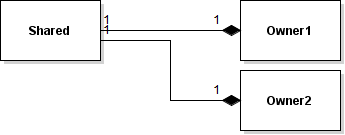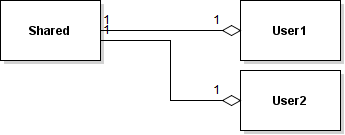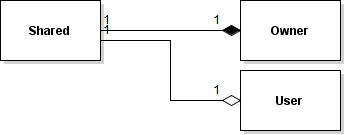As we all know has Qt types like QPointer, QSharedPointer and we know about its object trees. So when do we use what?
Let’s first go back to school, and remember the difference between composition and aggregation. Most of you probably remember drawings like this?

It thought us when to use composition, and when to use aggregation:
- Use composition when the user can’t exist without the dependency. For example a Human can’t exist without a Head unless it ceases to be a human. You could also model Arm, Hand, Finger and Leg as aggregates but it might not make sense in your model (for a patient in a hospital perhaps it does?)
- Use aggregate when the user can exist without the dependency: A car without a passenger is still a car in most models.
This model in the picture will for example tell us that a car’s passenger must have ten fingers.
But what does this have to do with QPointer, QSharedPointer and Qt’s object trees?
First situation is a shared composition. Both Owner1 and Owner2 can’t survive without Shared (composition, filled up diamonds). For this situation you would typically use a QSharedPointer<Shared> at Owner1 and Owner2:

If there is no other owner, then it’s probably better to just use Qt’s object trees and setParent() instead. Note that for example QML’s GC is not very well aware of QSharedPointer, but does seem to understand Qt’s object trees.
Second situation are shared users. User1 and User2 can stay alive when Shared goes away (aggregation, empty diamonds). In this situation you typically use a QPointer<Shared> at User1 and at User2. You want to be aware when Shared goes away. QPointer<Shared>’s isNull() will become true after that happened.

Third situation is a mixed one. In this case you could at Owner use a QSharedPointer<Shared> or a parented raw QObject pointer (using setParent()), but a QPointer<Shared> at User. When Owner goes away and its destructor (due to the parenting) deletes Shared, User can check for it using the previously mentioned isNull check.

Finally if you have a typical object tree, then use QObject’s infrastructure for this.
